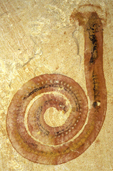 In the Yunnan
Province of China, paleobiologists have found evidence for exactly how certain
fossils were preserved in the Early Cambrian, around 525 million years ago.
This preservation process may shed light on what the worms and other animals
captured in the Chengjiang formation were made of, with the promise of determining
more details about many early life forms, including some of the earliest ancestors
to present-day vertebrates.
In the Yunnan
Province of China, paleobiologists have found evidence for exactly how certain
fossils were preserved in the Early Cambrian, around 525 million years ago.
This preservation process may shed light on what the worms and other animals
captured in the Chengjiang formation were made of, with the promise of determining
more details about many early life forms, including some of the earliest ancestors
to present-day vertebrates.Soft tissues from this worm from the Early Cambrian, about 525 million years ago, were preserved in the Chengjiang formation in China, replaced by tiny crystals of pyrite. The preservation process provides a rare look at early life forms that are related to present-day vertebrates and other animals. Copyright: Derek Siveter.
The soft tissues of Chengjiang worms, arthropods and other creatures were replaced by pyrite very quickly after the animals died. Now the Chengjiang site is one of a few major deposits in the world that contain well-preserved fossils from the Cambrian explosion, a period when the diversity of life increased rapidly. The best known of these deposits is the Burgess Shale, in which the soft tissues of fossils were preserved in fine detail by clay mineralization, and which have influenced thought on Cambrian species diversification for decades. But lately, fossils from the older Chengjiang — which includes organisms also in the Burgess — have become a major part of the discussion.
Sarah Gabbott of the University of Leicester and her co-workers, publishing in the October Geology, used scanning electron microscope imaging and chemical mapping to elucidate the different forms of pyrite that replaced some of the Chengjiang fossils. The researchers found three shapes of pyrite crystals, seemingly separated by tissue type: framboids (tiny raspberry-shaped crystals), octahedra and cubes. For example, in several worm specimens, they found that raspberry-shaped crystals seemed to replace the outermost soft tissues, but octahedra replaced the hardened plates on the animals.
The shape differences may indicate the speed of tissue decay and environmental conditions, Gabbott says. In this case, the environment in the Chengjiang had the right mix of iron-bearing water in the sediments and hydrogen sulfide from rotting carcasses. Different bacteria broke down the animal tissues and freed up the iron to make it available to form pyrite on the animals’ decaying surfaces.
“It’s all about getting the right ingredients together in the right place at the right time,” Gabbott says, comparing the process to cooking. “The faster you supply your ingredients, the more little [pyrite] nuclei form, and the more likely you are to get little raspberries,” she says, which formed on very soft outer tissues that were likely to decay very quickly. More durable soft tissues that decay more slowly leave time for pyrite to grow in more regular forms, she says, such as octahedra or cubes. The comparison of the pyrite crystals’ forms can help researchers “understand a little bit more of what the animal is like,” she says.
Carlton Brett, an invertebrate paleontologist at the University of Cincinnati, says that few researchers have considered why these animals were preserved at all and why such accumulations do not commonly occur later in geologic time. “Such deposits don’t occur very frequently after the Cambrian,” Brett says, perhaps because of other environmental factors, such as burrowing by animals that disturbs pyrite crystallization. Gabbott and her team “have greatly improved our understanding of these processes.”
“If we understand how the preservation occurred, we have a much better chance of actually targeting settings for these types of fossils,” says Derek Briggs, a paleobiologist at Yale University in New Haven, Conn., who specializes in the Cambrian. Also, he says, the fast mineralization of soft tissues saved a wealth of information about these creatures, which is especially important when “you are dealing with animals that don’t have any close living relatives.”
The Chengjiang site is particularly important because it provides insight into the earliest stages of evolution of multi-celled creatures, including early offshoots of the lineage leading to vertebrates, Briggs says. The Chengjiang holds more information about vertebrate species than the Burgess Shale, which, he says, “adds a certain amount of excitement” to discoveries from the deposits.

